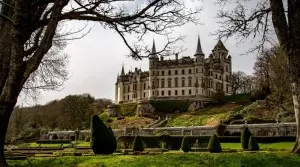Sights and Society: Remembering the History as a Tourist


A perk of studying abroad with IFSA-Butler: the excursions that are included in the cost.
Last week, IFSA organized a trip to the Highlands for all the students on the Scotland program—that’s around 100 of us from four cities, on four buses on a four-hour drive. (I don’t know why but four seems to be the magic number of the weekend…)
It was a very busy weekend—we left at 8 a.m. on Friday morning, making stops along the way until we got to Inverness around 6 p.m., then spent another full day on Saturday and returned to Edinburgh at about 4 p.m. on Sunday. It was amazing how much culture and history we saw. My favorite part, though, was seeing Dunrobin Castle on Saturday morning.
A Beautiful Day to Be Royal
Dunrobin Castle, as seen from the gardens.
Somehow we were running ahead of schedule, so we were able to wander the grounds for 15 minutes before the castle-turned-museum opened to the public.
I spent the first five minutes snapping as many pictures as I could because the building, parts of which date as far back as the 14th century, looked just like Cinderella’s palace from the Disney movie. White stone, turrets, even the little curley-cue gate. It didn’t hurt that the weather was unbelievably perfect—just the rarest cloud drifting lazily across the sky, the wind down to a murmur compared to the chill of the day before.
There were woods on either side, but I’d seen the hint of water behind the gate, so I followed the path. (Yes, I ignored the “No unauthorized vehicles past this point” sign, but people aren’t vehicles! Right?) It dipped down steeply, curving along the side of the castle walls. It trailed along the gardens, offering tantalizing glimpses of the elegant, green and arching fountains behind the gates. Eventually, the path opened wide and suddenly the North Sea was spread out before me, calm waves whispering and glittering in the bright sunlight. I can’t imagine a more picture perfect view. With the castle behind me, I really felt like royalty.
More than just Beauty: History of the Highland Clearances
However, physical beauty is not the castle’s only appeal. Dunrobin Castle and the family that owns it have long been associated with a very important part of Scottish history—the Highland Clearances.
Beginning in the late 18th century, the lords—the wealthy landowners—realized it would be more profitable to keep herds of sheep instead of cattle. Previously, the cows that occupied the land were sold to the British army for beef, but as the Age of Imperialism was drew to a close, there was no longer any money to be made that way. So, sheep it was.
Not only could sheep be sold for both wool and meat, but they also required less care than cows. Consequently, the families that had worked for the lords for years, raising cattle and working the land in return for the right to live there, were sacked and forced to leave to make room for the sheep. Their homes were razed to ensure nobody could attempt to come back.
The hills of Glencoe were once occupied by the highlanders, before the clearance, but now the hills remain largely empty but for the tourists who pass through.
The tenant farmers were driven into cities or overseas, settling in Canada and the United States, or even as far away as Australia. This migration had a devastating effect on Gaelic and clan culture, dismantling centuries of tradition. Even today, the Highlands remain largely empty compared to the numerous small settlements that had dotted the hills in the past.
And the tension remains. Our tour guide told us that it would be impolite to bring up the history of the Clearances while in the castle, that the owners don’t like to talk about it. Apparently their ancestor, Elizabeth Gordon, Countess of Sutherland, executed a particularly brutal clearance beginning in 1785 for the sake of ‘land improvement’. The man she left in charge of the operation, called Patrick Sellar, burnt home after home, often giving the occupants no time at all to prepare. He was eventually brought up on charges of manslaughter for the ‘accidental’ deaths that occurred while carrying out his patronesses orders.
I’ve often found tourist sights to be rather paradoxical. Most become popular due to their scenery and their picturesque beauty. But often, these sites have their own history to tell, sometimes dark and despairing in contrast to the dazzling staging. It’s important to be aware of both sides of the picture—the beauty, but also the history and culture.